 W
WBody modification is the deliberate altering of the human anatomy or human physical appearance. It is often done for aesthetics, sexual enhancement, rites of passage, religious beliefs, to display group membership or affiliation, in remembrance of lived experience, traditional symbolism such as axis mundi and mythology, to create body art, for shock value, and as self-expression, among other reasons. In its broadest definition it includes skin tattooing, socially acceptable decoration, and religious rites of passage, as well as the modern primitive movement.
 W
WAn adornment is generally an accessory or ornament worn to enhance the beauty or status of the wearer. They are often worn to embellish, enhance, or distinguish the wearer, and to define cultural, social, or religious status within a specific community. When worn to show economic status, the items are often either rare or prohibitively expensive to others. Adornments are usually colourful, and worn to attract attention.
 W
WAmerican Mary is a 2012 Canadian body horror film written and directed by Jen and Sylvia Soska and starring Katharine Isabelle, Antonio Cupo, and Tristan Risk. Isabelle plays a destitute medical student who begins taking clients from the extreme body modification community to solve her financial troubles.
 W
WElayne Angel is an American professional body piercer.
 W
WArtificial cranial deformation or modification, head flattening, or head binding is a form of body alteration in which the skull of a human being is deformed intentionally. It is done by distorting the normal growth of a child's skull by applying force. Flat shapes, elongated ones, rounded ones, and conical ones are among those chosen or valued in various cultures. Typically, the shape alteration is carried out on an infant, as the skull is most pliable at this time. In a typical case, headbinding begins approximately a month after birth and continues for about six months.
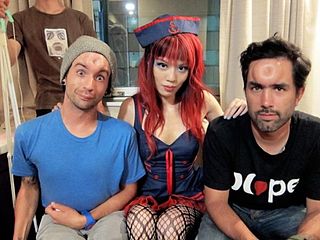 W
WBagel head is a type of body modification pioneered in Canada and practiced in the Japanese underground scene. It is a temporary swelling distortion of the forehead created by a saline drip and often shaped to resemble a bagel or doughnut. In 2012, after appearing on a National Geographic TV special, this practice became the subject of sensationalism as news outlets worldwide misleadingly declared it a "Japan trend".
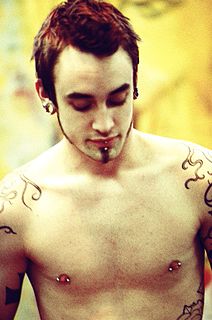 W
WBody piercing, which is a form of body modification, is the practice of puncturing or cutting a part of the human body, creating an opening in which jewelry may be worn, or where an implant could be inserted. The word piercing can refer to the act or practice of body piercing, or to an opening in the body created by this act or practice. It can also, by metonymy, refer to the resulting decoration, or to the decorative jewelry used. Piercing implants alter body and/or skin profile and appearance. Although the history of body piercing is obscured by popular misinformation and by a lack of scholarly reference, ample evidence exists to document that it has been practiced in various forms by multiple sexes since ancient times throughout the world.
 W
WA body suit or full body suit is an extensive tattoo, usually of a similar pattern, style or theme that covers the entire torso or the entire body.
 W
WBodybuilding is the use of progressive resistance exercise to control and develop one's musculature by muscle hypertrophy for aesthetic purposes. It is distinct from similar activities such as powerlifting because it focuses on physical appearance instead of strength. An individual who engages in this activity is referred to as a bodybuilder. In professional bodybuilding, competitors appear in lineups and perform specified poses for a panel of judges who rank them based on symmetry, muscularity, size, conditioning, posing, and stage presentation. Bodybuilders prepare for competitions through the elimination of nonessential body fat, enhanced at the last stage by a combination of extracellular dehydration and carbo-loading, to achieve maximum muscular definition and vascularity; they also tan and shave to accentuate the contrast of their skin under the spotlights.
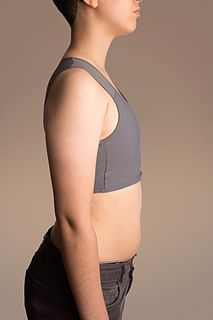 W
WBreast binding is the act of flattening breasts by the use of constrictive materials. The term also refers to the material used in this act. Common binding materials include cloth strips, purpose-built undergarments, often using spandex or other synthetic fiber, and shirts layered from tight to loose. The act of breast binding is common for trans men, but is also done by androgynous and non-binary people, as well as crossdressers, cosplayers, and performers. In a general sense, women may also use binders as alternatives to bras or as a practice of propriety.
 W
WA corset is a garment worn to hold and train the torso into a desired shape, traditionally a smaller waist or larger bottom, for aesthetic or medical purposes, or support the breasts. Both men and women are known to wear corsets, though this item was for many years an integral part of women's wardrobes.
 W
WCranioplasty is a surgical operation on the repairing of cranial defects caused by previous injuries or operations, such as decompressive craniectomy. It is performed by filling the defective area with a range of materials, usually a bone piece from the patient or a synthetic material. Cranioplasty is carried out by incision and reflection of the scalp after applying anaesthetics and antibiotics to the patient. The temporalis muscle is reflected, and all surrounding soft tissues are removed, thus completely exposing the cranial defect. The cranioplasty flap is placed and secured on the cranial defect. The wound is then sealed.
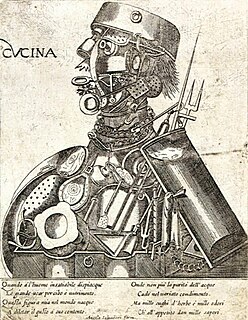 W
WCyborg art, also known as cyborgism, is an art movement that began in the mid-2000s in Britain. It is based on the creation and addition of new senses to the body via cybernetic implants and the creation of art works through new senses. Cyborg artworks are created by cyborg artists; artists whose senses have been voluntarily enhanced through cybernetic implants. Among the early artists shaping the cyborg art movement are Neil Harbisson, whose antenna implant allows him to perceive ultraviolet and infrared colours, and Moon Ribas whose implants in her feet allow her to feel earthquakes and moonquakes. Other cyborg artists include:Manel De Aguas, a Catalan photographer who developed fins that allow him to perceive atmospheric pressure, humidity and temperature through a couple of implants at each side of his head. Joe Dekni, an artist who has developed and installed a radar system in his head. The sensory system includes two implants in his cheekbones. Pau Prats, creator of a system that allows him to feel the ultraviolet ray levels that reach his skin. Alex Garcia, whose sensor installed in his chest allows him to feel the air quality levels around him. Kai Landre, a musician developing two implants to hear the sound of the particles affected by the collusion of cosmic rays.
 W
WDueling scars have been seen as a "badge of honour" since as early as 1825. Known variously as "Mensur scars", "the bragging scar", "smite", "Schmitte" or "Renommierschmiss", dueling scars were popular amongst upper-class Austrians and Germans involved in academic fencing at the start of the 20th century. Being a practice amongst university students, it was seen as a mark of their class and honour, due to the status of dueling societies at German and Austrian universities at the time, and is an early example of scarification in European society. The practice of dueling and the associated scars was also present to some extent in the German military.
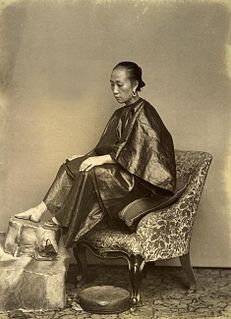 W
WFoot binding was the Chinese custom of breaking and tightly binding the feet of young girls in order to change the shape and size of their feet; during the time it was practiced, bound feet were considered a status symbol and a mark of beauty. Feet altered by foot binding were known as lotus feet, and the shoes made for these feet were known as lotus shoes.
 W
WGenital piercing is a form of body piercing that involves piercing a part of the genitalia, thus creating a suitable place for wearing different types of jewellery. Nevertheless, the term may also be used pars pro toto to indicate all body piercings in the area of anus, perineum, genitals and mons pubis, including piercings such as anal, guiche, and pubic that do not involve perforation of genitalia. Genital piercings can be done in men or women, with various forms of piercings available. The main motive for both genders is beautification and individualization; in addition, some piercings enhance sexual pleasure by increasing stimulation. Genital piercings can be found in many tribal societies, in particular in South and East Asia, where it has been part of traditional practice since ancient times. Early records of genital piercing are found in the Kama Sutra that was written over 2000 years ago.
 W
WGrindhouse Wetware is an open source biotechnology startup company based in Pittsburgh, Pennsylvania. Grindhouse applies the biohacker ethic to create technology that augments human capabilities. The company is most well known for their Circadia device, a wireless biometric sensor that was implanted into co-founder Tim Cannon on the 22 October 2013. Grindhouse has been featured in television shows such as Taboo on National Geographic Channel, Joe Rogan Questions Everything on Syfy, The Big Picture with Kal Penn, as well as podcasts including Future Grind and Roderick Russell's Remarkably Human.
 W
WHeartbeat in the Brain is a 1970 documentary film produced and directed by Amanda Feilding, an advocate of trepanation. In the film, Feilding, a 27-year-old student at the time, drills a hole in her forehead with a dentist's drill. In the documentary, surgical scenes alternate with motion studies of Feilding's pet pigeon Birdie.
 W
WHuman genetic enhancement or human genetic engineering refers to human enhancement by means of a genetic modification. This could be done in order to cure diseases, prevent the possibility of getting a particular disease, to improve athlete performance in sporting events, or to change physical appearance, metabolism, and even improve physical capabilities and mental faculties such as memory and intelligence. These genetic enhancements may or may not be done in such a way that the change is heritable.
 W
WHuman tooth sharpening is the practice of manually sharpening the teeth, usually the front incisors. Filed teeth are customary in various cultures. Many remojadas figurines found in part of Mexico have filed teeth and it is believed to have been common practice in their culture. The Zappo Zap people of the Democratic Republic of Congo are believed to have filed their teeth.
 W
WIn body modification, an implant is a device is placed under the human skin for decorative purposes. Such implants may be subdermal or transdermal. In the context of body modification, some may consider injections of silicone and other substances a type of implant as well.
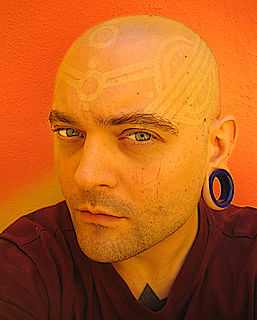 W
WShannon Larratt was the creator, former editor and publisher of BMEzine, an online magazine noted for coverage of extreme body modifications. He published several books, including ModCon: The Secret World Of Extreme Body Modification. He was also an artist, computer programmer, film producer and business owner.
 W
WThe lip plate, also known as a lip plug or lip disc, is a form of body modification. Increasingly large discs are inserted into a pierced hole in either the upper or lower lip, or both, thereby stretching it. The term labret denotes all kinds of pierced-lip ornaments, including plates and plugs. It is most common in African native tribes.
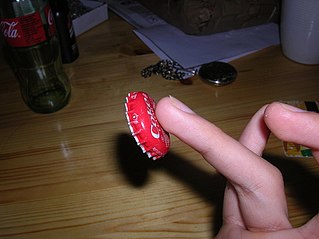 W
WMagnetic implantation is an experimental procedure in which small, powerful magnets (neodymium) are inserted beneath the skin, often in the tips of fingers. They exist in tubes and discs. This procedure is popular among biohackers and grinders, but remains experimental. Magnetic implants are often performed by amateurs at home, using readily available surgical tools and magnets found online. However, some professional body modification shops do perform implant surgeries. Magnetic implants can also be used as an interface for portable devices to create other new "senses", for example converting other sensory inputs such as ultrasonic or infra-red into a touch sensation. In this way the individual could 'feel' e.g. the distance to objects.
 W
WA manicure is a cosmetic beauty treatment for the fingernails and hands performed at home or in a nail salon. A manicure consists of filing and shaping the free edge of nails, pushing and clipping any nonliving tissue, treatments with various liquids, massage of the hand, and the application of fingernail polish. When the same is applied to the toenails and feet, the treatment is referred to as a pedicure. Most nail polish can stay on nails for 2–3 weeks before another manicure, if there is no deliberate damage to it.
 W
WNeck rings, or neck-rings, are any form of stiff jewellery worn as an ornament around the neck of an individual, as opposed to a loose necklace. Many cultures and periods have made neck rings, with both males and females wearing them at various times.
 W
WA pedicure is a cosmetic treatment of the feet and toenails, analogous to a manicure. Pedicures are done for cosmetic, therapeutic purposes. They are popular throughout the world, and especially among women.
 W
WPotong gigi, also known as mesangih or mepandes, is a form of ritual body modification of adolescents, typically teenagers, in parts of Bali that involves the filing of the canine teeth. Traditional Balinese belief states that "protruding canines represent the animal-like nature of human beings"; the purpose of the ritual is to sever ties with these animal instincts and show others that the individual is old enough to marry. Considered a generational ritual, parents of adolescents performing it consider it their "final duty" in being a parent before their child becomes an adult. Reasons adolescents take part in the ceremony are mixed, as they must take into consideration the impacts of globalization with traditional Balinese ritual.
 W
WScarifying involves scratching, etching, burning / branding, or superficially cutting designs, pictures, or words into the skin as a permanent body modification. The body modification can take roughly 6–12 months to heal. In the process of body scarification, scars are formed by cutting or branding the skin by varying methods, to purposely influence wound healing to scar more and not scar less. Scarification is sometimes called cicatrization.
 W
WSocket is an independent sci-fi erotic thriller directed by Sean Abley, produced by John Carrozza, Sean Abley, Matt Mishkoff and Doug Prinzivalli, and starring Derek Long as Dr. Bill and Matthew Montgomery as Dr. Craig Murphy. It was released in 2007.
 W
WStrangeland is a 1998 American slasher film written by Dee Snider and directed by John Pieplow. The film centers around a police detective trying to save his city, as well as his daughter, from an online predator who enjoys bringing "enlightenment" through ritual pain.
 W
WA subdermal implant refers to a body modification that is placed underneath the skin, therefore allowing the body to heal over the implant and creating a raised design. Such implants fall under the broad category of body modification. Many subdermal implants are made out of silicone, either carved or mold injected. Many people who have subdermal implants use them in conjunction with other types of body modification to create a desired, dramatic effect. This process is also known as a 3-D implant, or pocketing.
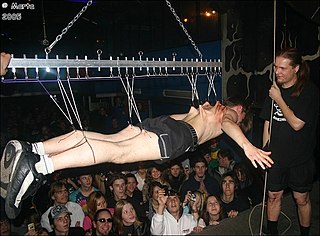 W
WBody suspension means the act of rigging a human body to hang from implements that have been placed through temporary perforations in the skin.
 W
WTightlacing is the practice of wearing a tightly-laced corset. It is done to achieve cosmetic modifications to the figure and posture or to experience the sensation of bodily restriction.
 W
WTongue bifurcation, splitting or forking, is a type of body modification in which the tongue is cut centrally from its tip to as far back as the underside base, forking the end.
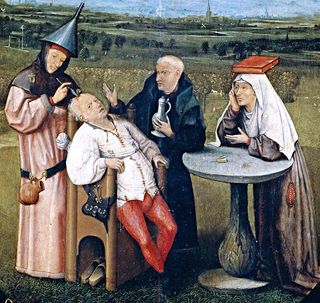 W
WTrepanning, also known as trepanation, trephination, trephining or making a burr hole is a surgical intervention in which a hole is drilled or scraped into the human skull. The intentional perforation of the cranium exposes the dura mater to treat health problems related to intracranial diseases or release pressured blood buildup from an injury. It may also refer to any "burr" hole created through other body surfaces, including nail beds. A trephine is an instrument used for cutting out a round piece of skull bone to relieve pressure beneath a surface.
 W
WA vajazzle, also spelled vagazzle, or glitter pubes is a form of genital decoration, formed by the application of crystal ornaments on the shaved mons pubis of a woman. The process is known as vajazzling, a portmanteau of "vajayjay" and "bedazzle". Vajazzling was popularized by actress Jennifer Love Hewitt, who devoted a chapter in her book The Day I Shot Cupid to vajazzling. During a promotional interview on Lopez Tonight in 2010, she encouraged the female members of her audience "to vajazzle their vajayjays". In the United Kingdom, the concept was popularized when beautician Amy Childs appeared in the television show The Only Way Is Essex in 2010. By 2011, an Internet rating site for vajazzling called Rate My Vajazzle had been set up.
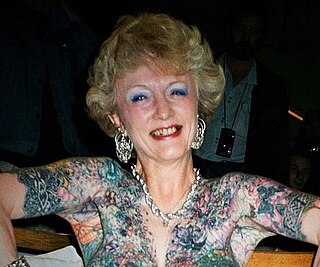 W
WIsobel Varley was a Guinness World Records-recognized tattooed senior, from Yorkshire, United Kingdom. She was first named "The World's Most-Tattooed Senior Woman" in 2000.
 W
WThe Yoruba tribal marks are scarifications which are specific identification and beautification marks designed on the face or body of the Yoruba people. The tribal marks are part of the Yoruba culture and are usually inscribed on the body by burning or cutting of the skin during childhood. The primary function of the tribal marks is for identification of a person's tribe, family or patrilineal heritage. Other secondary functions of the marks are symbols of beauty, Yoruba creativity and keeping mischievous children alive. This practice was popular among Yoruba people of Nigeria, Benin, and Togo. During the trans-Atlantic slave trade, tribal identification and facial stripes became important. Some repatriated slaves later reunited with their communities by looking at facial stripes.